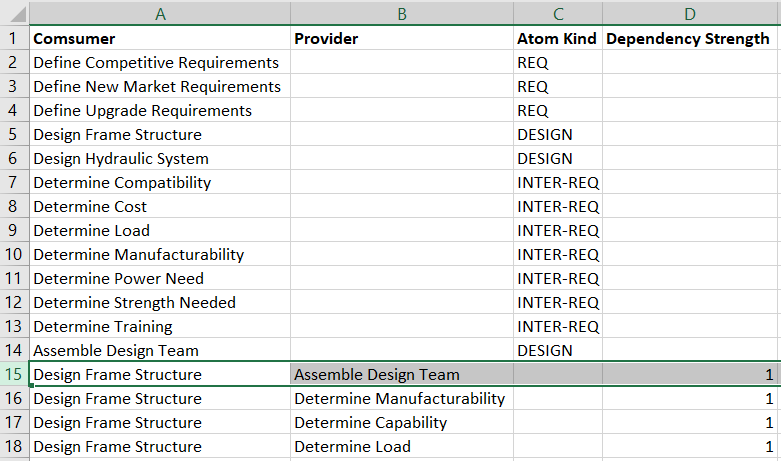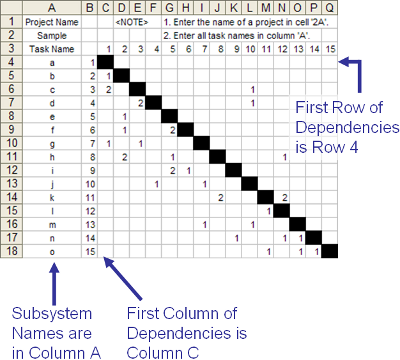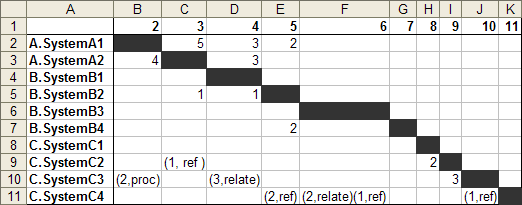Excel#
The Excel Module allows you to create projects from Excel files. Both xls and xlsx file types are supported. However, they are treated as different file types. Therefore, when updating a project, the file type should be preserved.
Options#
The Options tab allows you to select the options for reading in an Excel spreadsheet:
Name of Worksheet: Specify the name of the Worksheet to be used. If not specified, the first worksheet in the Excel file is used.
Hierarchy Delimiter Character: By default the character is ‘.’. Set it to a different character such as ‘/’, “:’, ‘' or anything else.
Excel Format: Choose the format to be Column or Matrix.
Always Create Target/Provider Subsystems: Forces the target/provider subsystems to be created even if they aren’t defined. Applicable only in the case of Column Format.
In addition there are other options specific to the Matrix format. The meaning of these options is described in the Matrix Format section.
Excel File Format#
The Excel Module for Lattix reads input data in two formats:
Column Format: In the column format, the data is organized in columns. You can load in atoms, atom kinds, atom properties, dependencies, dependency kinds and dependency properties.
Matrix Format: In the matrix format, the data is organized in a format similar to a DSM. Lattix supports a generic DSM format as well as the MIT format which is often used in many applications.
Column Format#
The column format allows you to use multiple worksheets. Each worksheet begins with a header row that specifies the definition of what is in each column. The header is always in the first row and its text is case insensitive. While not required, we suggest that you create at least two worksheets - one for defining subsystems and another for defining dependencies.
The module looks for the following strings in each of the columns of the header row:
Source Atom or Consumer: Name of source/consumer subsystem. This field is always required.
Atom Kind: Type of source subsystem. This field may be left blank.
Description: A textual description of the source/consumer subsystem. This field may be left blank.
Target Atom or Provider: Name of target/provider subsystem. This field should be left blank when specifying source/consumer system type, description, and properties. Target/provider must be specified when there is a Dependency Kind and Dependency Strength.
Dependency Kind: The kind of dependency. If this field is blank, the dependency kind is set to a value of “default.”
Dependency Strength: The strength of dependency. If this field is blank or set to zero, dependency is not created.
Property property-name: There can be any number of columns for different properties associated with the source subsystem. You can also use the special property #tag to tag source elements with tag values within Lattix. You can also have multiple tags for the source elements by combining them with the OR sign “||” (See example4.xls below).
Dependency Property property-name: There can be any number of columns for different properties associated with Dependencies.


Example Excel Spread Sheets#
Activity.xls,Options#
Name of Worksheet: The name of the worksheet to be read. If this field is left blank, all worksheets will be read.
Hierarchy Delimiter Character: The character that is taken as hierarchy delimiter. For the delimiter character dot (‘.’), elements A.A1 and A.A2, will group partitions A.A1 and A.A2 together in a single partition A.
Always Create Target Subsystem: If this option is set, a target subsystem is always created within the DSM. If this option is not set, a subsystem is only created for each of the subsystems in the the source column. Therefore, if there is a subsystem that is only in the Target Column but not in the Source Column, and this option is not set, then Target subsystem will appear only as an external dependency.
Matrix Format#
The spread sheet is assumed to be in a format similar to a DSM. The subsystem names are in the row headers. It may also have column headers. The number of column headers is assumed to be the same as the number of row headers.

The image above shows an excel spread sheet in a format compatible with MIT macros. The Lattix Module allows you to configure columns for the row headers as well as a row for the column header.
The Cell Format#

Each cell of the dependency grid can be any of the forms:
Number - This is the strength of the dependency
(Number, String) - The number is the strength of the dependency and the string is the type of the dependency.
Options#
Name of Worksheet: The name of the worksheet which will be generated. By default, it will use the first worksheet if this field is left blank.
Hierarchy Delimiter Character: The character that is taken as hierarchy delimiter. For the delimiter character dot (‘.’), elements A.A1 and A.A2, will group partitions A.A1 and A.A2 together in a single partition A.
Excel File in MIT Format: Select if the spread sheet is in MIT format. If so, the name column header is set to column ‘A’, the first column of dependencies is set to column ‘C’, the first row of dependencies is set to ‘4’ and dependencies are read along a row.
Read Dependencies: Choose Across Row or Down Column. Note that the MIT spread sheet normally defaults for reading across a row, while Lattix defaults reading down a column. If you are reading in MIT format spread sheets, choose across a row for how the dependencies should be read in. In order to display the DSM in Lattix in MIT spread sheet format, select View->Preferences and set Dependency Mark Orientation to be Across Rows and Subsystem Ordering to be Provides over Depends.
Element Names Column: Specify the letter for the column that contains element names.
First Data Column: Specify the letter for the column that is the first column of dependencies.
First Data Row: Specify the number of the row that contains the first row of dependencies.
Example Excel Spread Sheets#
Here are a few examples: example1.xls,
example2.xls,
example3.xls.
Here is an example of an excel
spread sheet in the MIT format. This example was taken from the dsm website.
